Painting vs. Staining Your Deck and Fence
Painting vs. Staining Your Deck and Fence
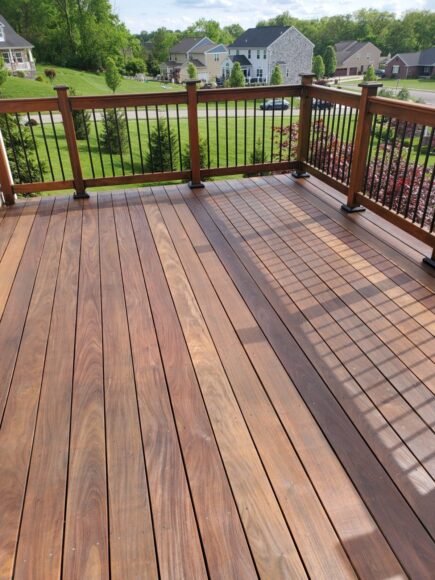
Your deck and fence are vital parts of your outdoor living space, providing a backdrop for relaxation, entertainment, and curb appeal. When it comes to preserving and enhancing these structures, one common dilemma homeowners face is whether to paint or stain them. Each option has its own set of pros and cons, and understanding them can help you make an informed decision that suits your needs and preferences.
Pros of Painting Your Deck and Fence:
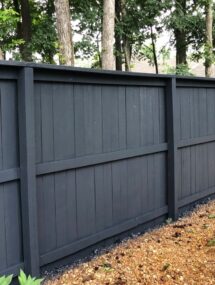
1. Color Variety: Painting offers an extensive range of color options, allowing you to match or complement your home’s exterior décor. Whether you prefer bold hues or subtle tones, you can achieve the desired aesthetic with paint.
2. Enhanced Protection: Paint forms a protective barrier on the surface of the wood, shielding it from moisture, UV rays, and harsh weather conditions. This can help prevent rot, decay, and premature aging, ultimately prolonging the lifespan of your deck and fence.
3. Easy to Clean: Painted surfaces are typically easier to clean than stained ones. You can simply wash away dirt, debris, and stains with soap and water, maintaining a fresh appearance with minimal effort.
4. Smooth Finish: Painting can create a smooth, uniform finish, concealing imperfections in the wood and providing a polished look. This can be particularly advantageous for older or weathered structures that may have aesthetic flaws.
Cons:
1. Prone to Peeling and Chipping: Over time, painted surfaces are susceptible to peeling, chipping, and cracking, especially in areas with high foot traffic or exposure to elements. This can necessitate frequent touch-ups and maintenance to keep the deck and fence looking pristine.
2. Limited Wood Grain Visibility: Unlike staining, which enhances the natural beauty of the wood grain, painting covers it entirely. If you prefer the rustic charm of exposed wood, painting may not be the ideal choice.
3. Surface Preparation Required: Achieving a durable and long-lasting paint finish requires thorough surface preparation, including cleaning, sanding, and priming. This can be time-consuming and labor-intensive, particularly for larger structures.
4. Potential for Slipperiness: Painted surfaces can become slippery when wet, posing a safety hazard, especially on decks. Adding texture or non-slip additives to the paint can mitigate this risk but may alter the appearance.
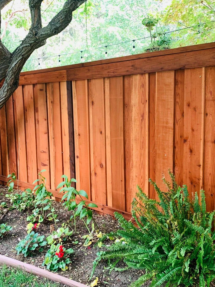
Pros of Staining Your Deck and Fence:
1. Enhanced Wood Grain Visibility: Unlike paint, stain penetrates the wood, enhancing its natural grain and texture. This results in a more organic and rustic appearance that complements outdoor surroundings.
2. Longer Maintenance Intervals: Stain typically requires less frequent maintenance than paint. While it may fade over time, it tends to wear more gracefully, with less peeling or chipping. Periodic reapplication of stain can rejuvenate the finish and protect the wood.
3. Breathability: Stain allows the wood to breathe, which is crucial for preventing moisture buildup and minimizing the risk of rot and mildew. This is particularly beneficial in humid or rainy climates where moisture retention can be a concern.
4. Ease of Application: Staining is often simpler and quicker to apply than paint, requiring minimal surface preparation in some cases. With various application methods available, including brushing, rolling, and spraying, homeowners can choose the most convenient option.
Cons:
1. Limited Color Options: While stains come in a variety of hues, they offer fewer color choices compared to paint. If you have specific color preferences or want to match existing elements, you may find the selection somewhat restrictive.
2. Less UV Protection: Stain provides some UV protection for the wood but may not be as effective as paint in blocking harmful rays. This could lead to gradual discoloration and fading over time, especially in sunny climates.
3. Difficulty in Concealing Imperfections: Stain does not mask surface imperfections as effectively as paint, as it allows the natural characteristics of the wood to show through. If your deck or fence has noticeable flaws, such as knots or blemishes, staining may accentuate rather than conceal them.
4. Potential for Uneven Application: Achieving a uniform stain finish can be challenging, especially for inexperienced DIYers. Uneven application or overlapping strokes may result in blotchy or streaky appearances, detracting from the overall aesthetic.
Choosing between painting and staining your deck and fence ultimately depends on your priorities, preferences, and practical considerations. While painting offers a wide range of colors and enhanced protection, staining showcases the natural beauty of the wood and requires less maintenance. By weighing the pros and cons of each option, you can make an informed decision that enhances the beauty and longevity of your outdoor living space. Whether you opt for the bold allure of paint or the rustic charm of stain, proper preparation and regular maintenance are key to preserving the integrity of your deck and fence for years to come.
The Ever-Evolving Palette: Trends in Exterior Painting
The Ever-Evolving Palette: Trends in Exterior Painting
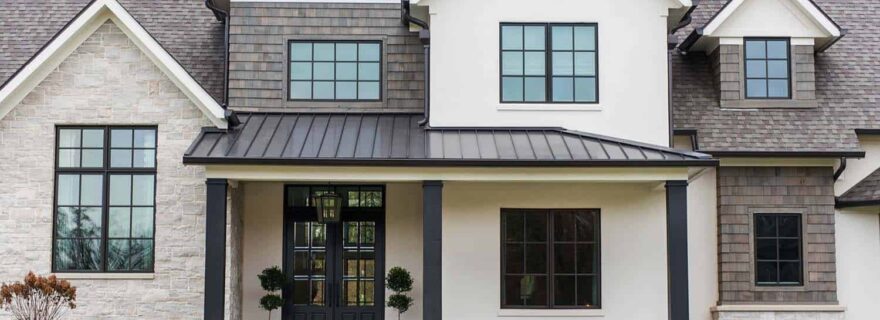
In the world of home design, the exterior of a house is like the cover of a book — it sets the tone for what lies inside. Just as interior design trends come and go, exterior painting trends also evolve over time, reflecting changes in tastes, technologies, and environmental concerns. Whether you’re looking to refresh your home’s façade or embark on a new build, staying aware of current exterior painting trends can help you create a look that’s both stylish and timeless. Let’s explore some of the exciting trends shaping the world of exterior painting.
1. Earth Tones and Natural Hues: In recent years, there has been a noticeable shift towards earthy and natural tones for exterior paint colors. Shades of warm beige, soft greys, olive greens, and muted blues are gaining popularity as homeowners seek to create harmonious connections with their natural surroundings. These colors not only blend seamlessly with the landscape but also evoke a sense of serenity and sophistication.
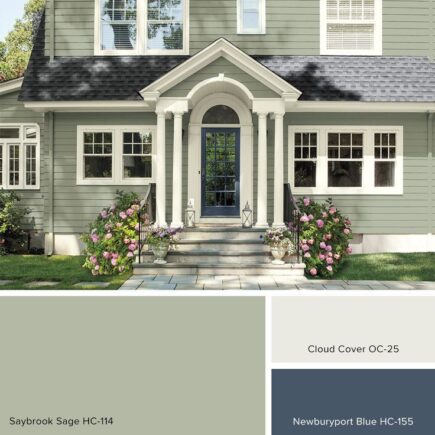
2. Bold Accents and Contrasts: While earth tones dominate as base colors, bold accents and contrasting hues are being used to add visual interest and personality to exteriors. Vibrant red doors, deep navy shutters, or rich mustard trim can inject character and charm into an otherwise neutral palette. This trend allows homeowners to showcase their individuality while maintaining overall curb appeal.
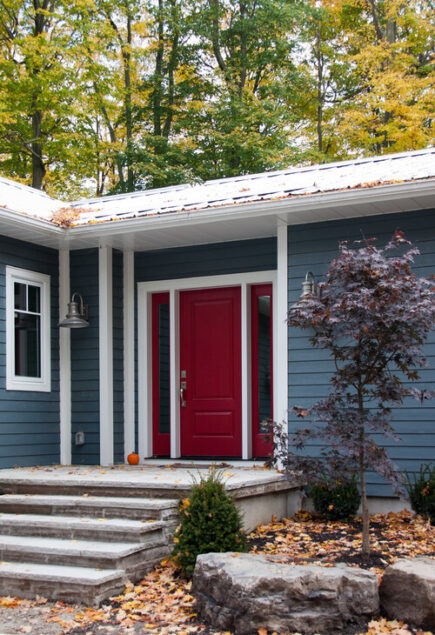
3. Dark and Dramatic: Embracing the dark side has become a daring trend in exterior painting. Deep charcoal, black, or dark navy exteriors are making a statement on residential streets. Contrary to the notion that dark colors make a house appear smaller, when paired with the right accents and landscaping, they can create a striking and sophisticated façade that stands out from the crowd.
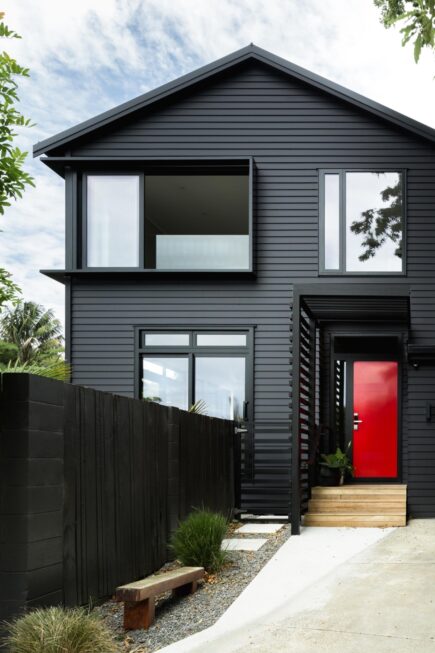
4. Texture and Dimension: Beyond color, texture and dimension are playing a significant role in exterior design. Techniques such as faux finishes, textured paints, and layered effects are being used to add depth and visual intrigue to surfaces. Textured accents like stone veneers, wooden cladding, or metal panels further enhance the tactile appeal of a home’s exterior, creating a dynamic interplay of light and shadow.
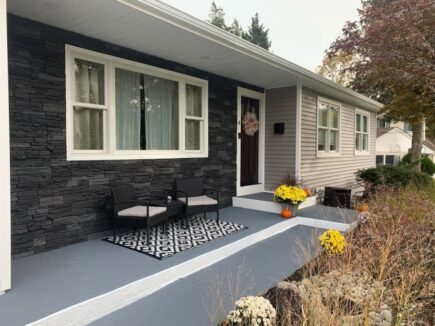
5. Modern Minimalism: Clean lines, simplicity, and understated elegance define the modern minimalist trend in exterior painting. Neutral palettes, sleek finishes, and minimalist detailing create a timeless aesthetic that exudes sophistication and sophistication. This trend is particularly popular in contemporary and mid-century modern architectural styles, where less is often more.
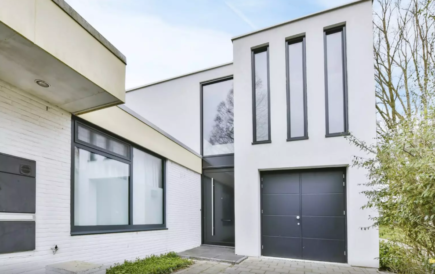
6. Heritage and Tradition: Nostalgia plays a significant role in shaping exterior painting trends, with many homeowners drawing inspiration from heritage colors and traditional palettes. Classic combinations like white with black accents, colonial reds, or coastal blues evoke a sense of nostalgia while honoring architectural traditions. These timeless color schemes add a sense of heritage and permanence to any home.
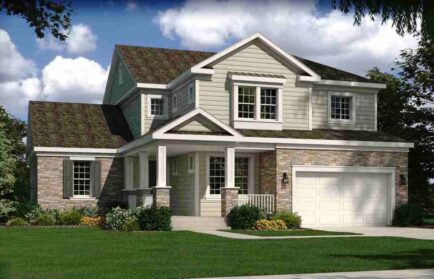
Exterior painting trends are as diverse and dynamic as the homes they adorn. Whether you prefer the timeless appeal of natural hues, the boldness of contrasting accents, or the modern simplicity of minimalist design, there’s a trend to suit every taste and style. Ultimately, the key is to choose colors and finishes that not only reflect your personal aesthetic but also enhance the architectural features and character of your home. With the right combination of color, texture, and creativity, your home’s exterior can become a true reflection of your individuality and style. If you don’t know where to start with your exterior project, Spectrum Painting is happy to offer free color consultations with our projects!
Elevate Your Kitchen: Exploring Popular Colors to Paint Kitchen Cabinets
Elevate Your Kitchen: Exploring Popular Colors to Paint Kitchen Cabinets
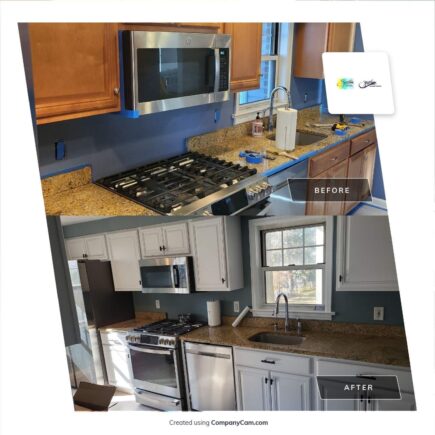
In the realm of kitchen design, the choice of cabinet color holds immense power in shaping the ambiance and aesthetic appeal of the space. Whether you’re aiming for a timeless and classic look or a bold and contemporary statement, selecting the right paint color can breathe new life into your kitchen. In this guide, we’ll explore some popular Benjamin Moore and Sherwin Williams colors that are sure to elevate your kitchen cabinets to new heights of style and sophistication.
1. Pure White (SW7005)
Classic White Elegance:
Starting off with a timeless favorite, Pure White from Sherwin Williams’s collection is a pure and crisp white that brings an aura of cleanliness and brightness to any kitchen. Its versatility allows it to seamlessly blend with various design styles, from traditional to modern, making it a popular choice for those seeking a fresh and timeless aesthetic.
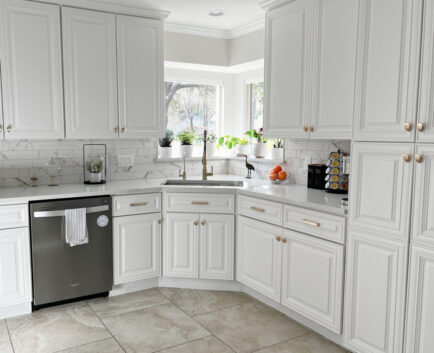
2. Hale Navy (HC-154)
Dramatic Sophistication:
If you’re looking to make a bold statement in your kitchen, consider Hale Navy. This rich and sophisticated navy blue hue adds depth and drama to cabinets, creating a sense of luxury and elegance. Pair it with brass or gold hardware for a striking contrast that exudes modern sophistication.
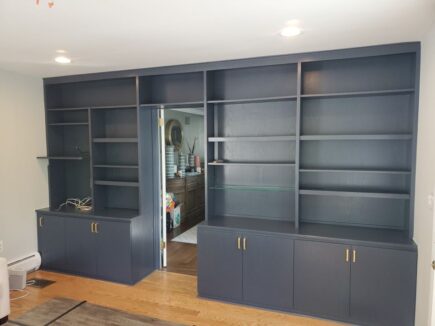
3. Revere Pewter (HC-172)
Subtle Warmth:
For those who prefer a softer, more understated look, Revere Pewter offers a perfect balance of warmth and neutrality. This versatile greige (gray-beige) hue complements a wide range of color palettes and materials, making it an excellent choice for creating a cozy and inviting atmosphere in the kitchen.
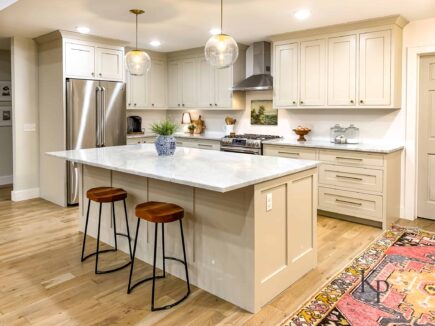
4. Kendall Charcoal (HC-166)
Contemporary Edge:
For a contemporary twist on classic gray, consider Kendall Charcoal. This deep and rich charcoal gray adds a sense of drama and modernity to kitchen cabinets, making them stand out as a focal point in the space. Pair it with sleek stainless steel appliances and minimalist hardware for a stylish, urban-inspired look.

5. Simply White (OC-117)
Clean and Crisp:
Another popular choice from Benjamin Moore’s collection is Simply White, a versatile shade that exudes purity and simplicity. Its clean and crisp appearance makes it an ideal option for creating a bright and airy feel in the kitchen, while also allowing other design elements to take center stage.
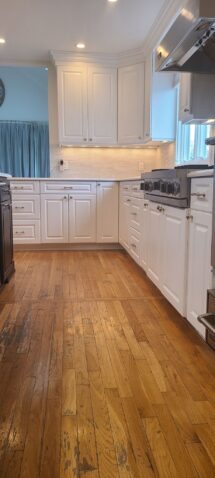
When it comes to painting kitchen cabinets, Benjamin Moore and Sherwin Williams offers a wide array of colors that cater to every style and preference. Whether you’re drawn to the timeless elegance of Pure White, the dramatic sophistication of Hale Navy, or the subtle warmth of Revere Pewter, there’s a color that can transform your kitchen into a space that reflects your personality and taste. So, dare to explore the possibilities and let your kitchen cabinets become a canvas for creativity and style! Spectrum Painting is also happy to offer a free color consultations for your project if you need professional color help!
Accent Walls: Enhancing Spaces or Design Distraction?
Accent Walls: Enhancing Spaces or Design Distraction?
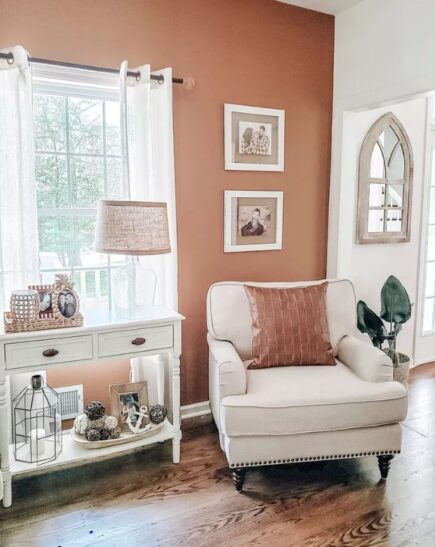
Accent walls have become a popular interior design trend in recent years, offering homeowners and decorators an opportunity to inject personality and creativity into their spaces. However, like any design choice, accent walls come with their own set of pros and cons. In this blog post, we’ll explore the advantages and disadvantages of accent walls to help you decide whether they’re the right choice for your home.
Pros:
- Adds Visual Interest: One of the primary advantages of accent walls is their ability to add visual interest to a room. By painting or wallpapering just one wall in a different color or pattern, you can create a focal point that draws the eye and adds depth to the space.
- Defines Spaces: In open-concept floor plans, accent walls can help define different areas within a room. For example, painting the wall behind a sofa in the living room a different color can delineate the seating area from the rest of the space, creating a sense of cohesion and organization.
- Highlights Architectural Features: Accent walls can be used to highlight architectural features such as fireplaces, built-in shelving, or alcoves. By painting or wallpapering the wall surrounding these features, you can make them stand out and become the focal point of the room.
- Easy to Change: Unlike painting an entire room or investing in expensive furniture, creating an accent wall is a relatively low-cost and low-commitment way to update your space. If you get tired of the color or pattern, it’s easy to repaint or remove the wallpaper and try something new.
- Expresses Personal Style: Accent walls offer an opportunity for self-expression and creativity. Whether you prefer bold, vibrant colors or subtle, muted tones, you can use an accent wall to showcase your personal style and make a statement in your home.
Cons:
- Can Be Overwhelming: While accent walls can add visual interest, they can also overwhelm a space if not done correctly. Choosing a color or pattern that is too bold or busy can make the wall feel out of place and distract from the rest of the room’s décor.
- Limits Flexibility: Once you’ve committed to an accent wall, it can limit your flexibility in terms of furniture placement and décor choices. Certain colors or patterns may clash with existing furnishings, making it difficult to achieve a cohesive look.
- Trend-Dependent: Like any design trend, accent walls can quickly become dated. What may be popular and on-trend today could look outdated in a few years, requiring you to repaint or remove the accent wall to keep up with changing styles.
- Risk of Imbalance: In some cases, accent walls can create visual imbalance within a room. If not executed properly, they can make the space feel lopsided or disjointed, rather than cohesive and harmonious.
- Potential to Clash: If not carefully coordinated with the rest of the room’s color scheme and décor, an accent wall can clash with existing elements, creating a discordant visual effect rather than enhancing the space.
In conclusion, accent walls can be a versatile and impactful design element, but they’re not without their drawbacks. Before committing to an accent wall, carefully consider the pros and cons to ensure that it’s the right choice for your space and aesthetic preferences. When done thoughtfully, an accent wall can transform a room and elevate its design, but it’s important to approach the process with careful consideration and attention to detail.
Essential Spring Cleaning Checklists for a Clean and Inviting Space
Essential Spring Cleaning Checklists for a Clean and Inviting Space

As the days grow longer and the weather warms, spring presents the perfect opportunity to breathe new life into your home with a thorough cleaning routine. From decluttering and organizing to deep cleaning and maintenance tasks, a well-executed spring cleaning checklist can help rejuvenate your living space and create a fresh, inviting atmosphere. Let’s explore essential spring cleaning checklists to ensure your home is sparkling clean and ready to embrace the season.
Declutter and Organize:
1. Closets and Wardrobes: Start by decluttering your closets and wardrobes, purging items you no longer use or need. Donate gently used clothing, shoes, and accessories to local charities or shelters and discard any damaged or worn-out items. Organize remaining items by category or season for easy access.
2. Kitchen Cabinets and Pantry: Empty out kitchen cabinets and pantry shelves, discarding expired or unused food items and donating unopened non-perishable goods to food banks. Wipe down shelves, organize items by type or purpose, and consider investing in storage containers or organizers to maximize space and efficiency.
3. Home Office: Sort through paperwork, files, and office supplies, shredding outdated documents and organizing remaining items into labeled folders or storage bins. Clean and disinfect computer keyboards, monitors, and desk surfaces, removing dust and grime for a tidy and functional workspace.
Deep Cleaning Tasks:
1. Dusting and Vacuuming: Dust all surfaces, including furniture, shelves, baseboards, and ceiling fans, using a microfiber cloth or duster to trap dust particles effectively. Vacuum carpets, rugs, and upholstery, paying special attention to high-traffic areas and beneath furniture.
2. Windows and Window Treatments: Clean windows inside and out, removing dirt, grime, and streaks for a clear, unobstructed view. Wash window treatments, such as curtains, blinds, or shades, following manufacturer’s instructions or opting for professional cleaning services for delicate fabrics.
3. Appliances and Fixtures: Deep clean kitchen appliances, such as the refrigerator, oven, microwave, and dishwasher, both inside and out, removing food spills, grease, and debris. Scrub sinks, faucets, and countertops with a mild cleaner or vinegar solution to remove stains and disinfect surfaces.
Maintenance and Outdoor Tasks:
1. Gutters and Downspouts: Clear debris from gutters and downspouts to ensure proper drainage and prevent water damage to your home’s exterior. Use a ladder and gloves to remove leaves, twigs, and other obstructions, and consider installing gutter guards for added protection.
2. Outdoor Furniture and Patio: Clean and inspect outdoor furniture, cushions, and patio accessories, removing dirt, mold, and mildew with a gentle soap and water solution. Sweep or power wash outdoor surfaces, such as decks, patios, and walkways, to remove debris and stains accumulated during the winter months.
3. Landscaping and Gardening: Trim bushes, shrubs, and trees to promote healthy growth and remove dead or overgrown foliage. Rake and dispose of leaves, twigs, and debris from flower beds, lawn areas, and garden plots, and consider planting seasonal flowers or vegetables to add color and vibrancy to your outdoor space.
4. Soft Washing and Painting: Now’s the time to wash off the leftover debris and dirt from winter from your house, walkways, decks, patios and even the roof! After cleaning is complete, now is the best time to repaint or change the color of your exterior or give your deck a fresh coat of stain!
By following these comprehensive spring cleaning checklists, you can transform your home into a clean and inviting sanctuary, ready to embrace the beauty and freshness of the season. Whether you tackle one room at a time or enlist the help of family members or professional cleaning services, investing time and effort into spring cleaning will leave your home feeling renewed and revitalized for the months ahead!
Green Envy: Exploring the Most Popular Shades for Your Home's Exterior
Green Envy: Exploring the Most Popular Shades for Your Home's Exterior
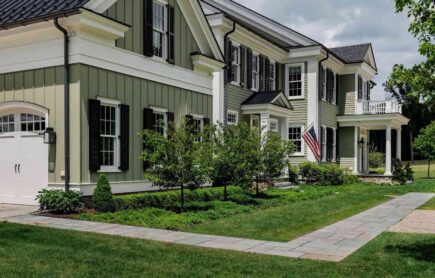
When it comes to choosing a color for your home’s exterior, few options offer the timeless appeal and versatility of green. From serene pastels to deep, earthy tones, green hues can transform your home, evoking feelings of harmony, nature, and sophistication. Let’s delve into some of the most popular shades of green for painting the exterior of your home.
Sage Green: Soft and understated, sage green is a perennial favorite for exterior painting. With its subtle gray undertones, this muted hue exudes elegance and tranquility. Whether adorning a traditional farmhouse or a modern bungalow, sage green blends seamlessly with various architectural styles, lending a sense of timelessness and sophistication to your home’s exterior.
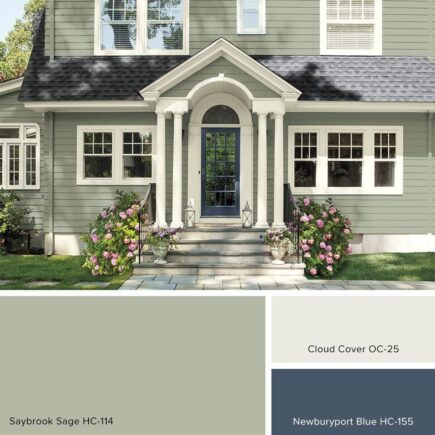
Olive Green: Reminiscent of sun-drenched Mediterranean landscapes, olive green infuses your home with warmth and character. This earthy hue, with its hints of yellow and brown, pairs beautifully with natural materials like stone or wood, creating a welcoming and rustic ambiance. Whether nestled in the countryside or nestled in the suburbs, olive green adds a touch of natural charm to any home exterior.
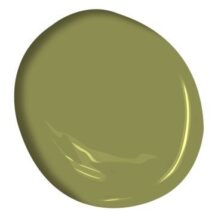
Forest Green: Bold and dramatic, forest green commands attention and adds a sense of richness to your home’s exterior. With its deep, velvety tones, this color creates a striking contrast against lighter accents, such as trim or shutters. Ideal for homes surrounded by lush foliage or nestled in wooded settings, forest green captures the essence of nature, making a bold statement while maintaining a sense of harmony with the environment.

Mint Green: Fresh and invigorating, mint green breathes new life into your home’s exterior. This light and airy hue instantly brighten up any space, creating a sense of vitality and freshness. Whether used as the main color or as an accent, mint green adds a playful touch to your home, perfect for those seeking a more whimsical and modern aesthetic.
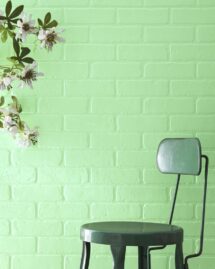
Teal Green: Sophisticated and chic, teal green offers a contemporary twist on traditional green hues. With its rich blue-green undertones, this color exudes elegance and sophistication, making it an ideal choice for modern residences or historic homes in need of a fresh update. Whether paired with crisp white accents or bold metallic finishes, teal green adds a touch of luxury to your home’s exterior, elevating its curb appeal and leaving a lasting impression.
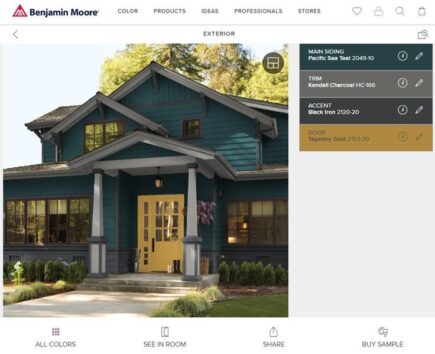
Whether you prefer the understated elegance of sage green or the boldness of teal green, there’s a shade of green to suit every taste and style. So why not breathe new life into your home’s exterior with a fresh coat of paint in one of these popular green hues? Whether you’re aiming for a timeless classic or a modern masterpiece, green is sure to make your home the envy of the neighborhood. Let Spectrum Painting help with your vision today!
Elevate Your Home's Exterior: Trendy Paint Colors to Consider
Elevate Your Home's Exterior: Trendy Paint Colors to Consider
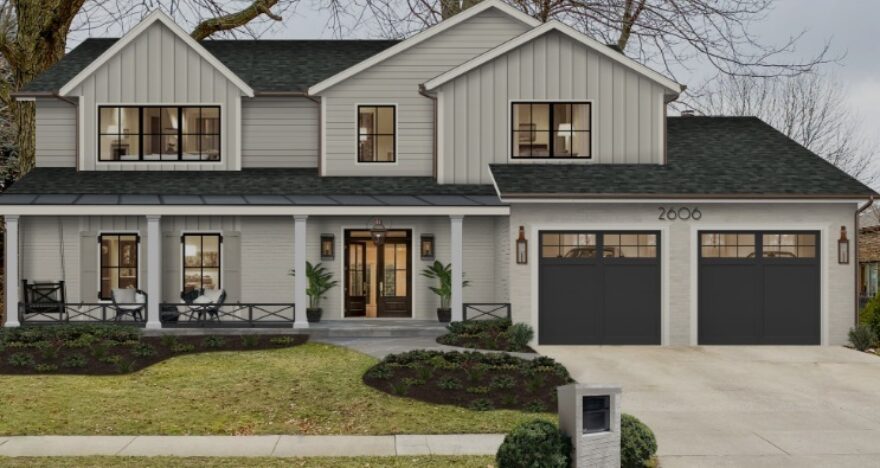
In the world of home design, the exterior is just as important as the interior. Your home’s facade sets the tone for its overall aesthetic, making a lasting impression on guests and passersby alike. Whether you’re giving your home a fresh coat of paint or embarking on a complete exterior makeover, choosing the right colors is essential. To help you stay ahead of the curve, we’ve curated a list of trendy paint colors that are sure to elevate your home’s exterior. Spectrum is also happy to provide a free color consultation with our color expert to help with your project!
Classic Navy: Navy blue has emerged as a timeless yet trendy choice for exterior paint. Its deep, rich hue exudes sophistication and pairs beautifully with a variety of architectural styles, from traditional to modern. Consider pairing navy with crisp white trim for a striking contrast that commands attention.
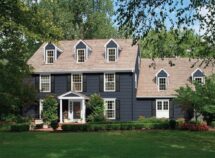
Earthy Greens: Embrace the tranquility of nature with earthy green tones for your home’s exterior. From sage to olive, green hues evoke a sense of serenity and harmony with the surrounding landscape. These colors work particularly well for homes nestled in lush, verdant settings, creating a seamless connection to the outdoors.
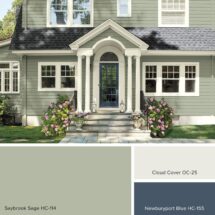
Warm Neutrals: Neutrals are a perennial favorite for exterior paint, and warm tones are currently in vogue. Shades like caramel, taupe, and warm beige offer a cozy, inviting vibe that complements a wide range of architectural designs. These versatile colors lend a sense of timelessness to your home’s exterior while still feeling modern and fresh.

Soft Blues: Soft, muted blues are gaining popularity for their soothing and calming effect. Think pale sky blue or dusty slate tones that add a touch of serenity to your home’s façade. These gentle hues are perfect for coastal or cottage-style homes, evoking the tranquil atmosphere of seaside retreats.
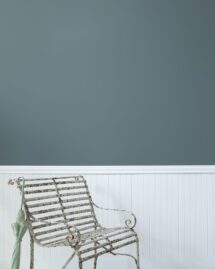
Bold Reds: For those who crave a pop of color, bold reds are making a comeback in exterior design. From vibrant crimson to deep burgundy, red exudes energy and personality. Use it strategically as an accent color for doors, shutters, or trim to make a bold statement without overwhelming the entire façade.

Modern Grays: Gray continues to reign supreme as a go-to neutral for contemporary homes. Opt for sophisticated charcoal or soft dove gray for a modern, minimalist look that oozes elegance. Gray pairs effortlessly with other hues and materials, allowing you to customize your home’s exterior to suit your personal style.

When choosing a paint color for your home’s exterior, it’s important to consider factors such as architectural style, surrounding landscape, and neighborhood regulations. Additionally, don’t forget to test paint samples on your home’s exterior and observe how they look in different lighting conditions throughout the day. We’re also happy to provide our color consultation services for your project, free of charge!
Ultimately, the goal is to select a paint color that not only reflects your personal taste but also enhances your home’s curb appeal and complements its architectural features. With these trendy paint colors as inspiration, you can give your home a stylish makeover that will leave a lasting impression for years to come.
Painting Interior Rooms with Shades of Red
Painting Interior Rooms with Shades of Red

In honor of Valentine’s Day, we thought we’d take a look at incorporating the color red into your home. Red, the color of passion, energy, and warmth, has the power to transform any interior space into a vibrant and inviting sanctuary. When it comes to painting interior rooms, incorporating various shades of red can evoke different moods and create stunning visual impacts. In this blog, we’ll explore the dynamic world of red hues and how they can redefine your living spaces.
Embracing the Warmth: Choosing the Right Shade
Before diving into the painting process, it’s crucial to select the perfect shade of red that aligns with your vision and complements your interior design scheme. Here are a few popular options:
Crimson Red:
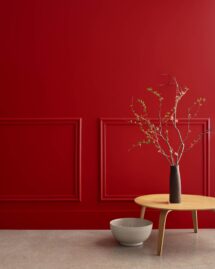
This deep, rich hue exudes elegance and sophistication. Ideal for creating a dramatic focal point in formal dining rooms or cozying up intimate spaces like libraries or home offices.
Scarlet Red:
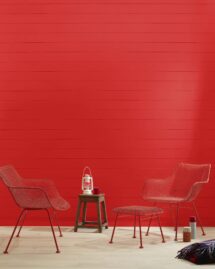
Vibrant and attention-grabbing, scarlet red injects energy and vitality into any room. Consider using it in areas where you want to stimulate conversation and social interaction, such as living rooms or entertainment areas.
Terracotta Red:
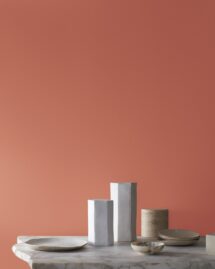
Warm and earthy, terracotta red brings a rustic charm to interiors. Perfect for accent walls in kitchens or bedrooms, it pairs beautifully with natural materials like wood and stone, creating a cozy, Mediterranean-inspired ambiance.
Burgundy Red:
Deep and luxurious, burgundy red exudes a sense of opulence and luxury. It’s an excellent choice for creating a sense of intimacy in bedrooms or adding a touch of glamour to formal dining spaces.
Give us a call today to schedule your estimate for your interior project and ask about our winter specials and color consultations!
Revitalize Your Home: The Power of Soft Washing
Revitalize Your Home: The Power of Soft Washing
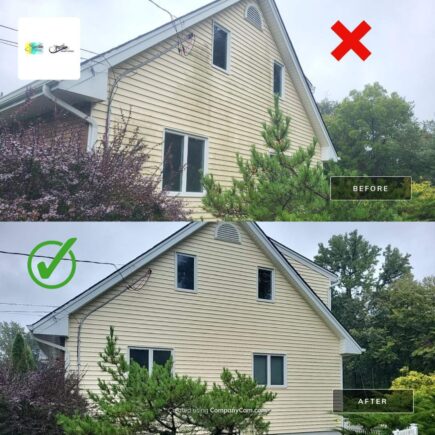
As homeowners, we take pride in the appearance of our properties. From the meticulously maintained gardens to the freshly painted fences, every aspect contributes to the overall aesthetic appeal. However, one area that often gets overlooked is the exterior surfaces of our homes. Over time, dirt, grime, mold, and mildew can accumulate, dulling the once vibrant facade. Fortunately, there’s a solution that can breathe new life into your property: soft washing. In this blog, we’ll explore the numerous benefits of Soft washing your home and other property, and why it should be an essential part of your maintenance routine.
- Restoring Curb Appeal: First impressions matter, especially when it comes to your home. A clean and well-maintained exterior instantly boosts curb appeal, making your property stand out in the neighborhood. Soft washing removes built-up dirt, stains, and discoloration, revealing the true beauty of your home’s siding, brick, concrete, and other surfaces. Whether you’re planning to sell your home or simply want to enhance its appearance, soft washing is a cost-effective way to achieve stunning results. Soft washing is also less abrasive than power washing can be, as we use low pressure.
- Protecting Your Investment: Your home is one of the biggest investments you’ll ever make, and proper maintenance is key to preserving its value. Regular soft washing helps prevent the accumulation of dirt, mold, and mildew, which can cause long-term damage to surfaces. By removing these contaminants, you’re not only maintaining the aesthetic appeal but also extending the lifespan of your exterior materials. This proactive approach can save you money on costly repairs down the line, ultimately protecting your investment.
- Health and Safety: Beyond aesthetics, soft washing contributes to a healthier and safer living environment. Mold, mildew, algae, and other organic growths not only detract from the appearance of your home but can also pose health risks to you and your family. These allergens can exacerbate respiratory issues and cause other health problems. Soft washing eliminates these potential hazards, creating a clean and hygienic outdoor space for you to enjoy. Additionally, removing slippery algae and moss from walkways and driveways reduces the risk of slips and falls, enhancing safety around your property.
- Preparation for Maintenance and Upgrades: Before embarking on any exterior maintenance or renovation projects, it’s essential to start with a clean slate. Soft washing provides a thorough and efficient way to prep surfaces for painting, staining, sealing, or other treatments. By removing dirt and debris, you ensure better adhesion and longevity of the finish. Whether you’re repainting your siding, refinishing your deck, or sealing your driveway, soft washing sets the stage for successful outcomes.
- Roof Maintenance: Keeping your roof clean and free of debris, algae and lichen is important in the overall stability of your roof. In some cases, when left dirty, the roof can prematurely age and can affect your ability to get homeowners’ insurance! With our method, lichen are killed off during the washing process and will continue to dry up and flake off with rainfall for about a month after washing is complete.
Conclusion: Soft washing is more than just a cosmetic enhancement—it’s a practical and beneficial investment in the upkeep of your property. From restoring curb appeal and protecting your investment to promoting health and safety, the advantages are undeniable. By incorporating soft washing into your regular maintenance routine, you’ll not only enhance the appearance of your home but also prolong its lifespan and value. So why wait? Revitalize your home today with the power of soft washing by Spectrum Painting!
Why Hiring a Professional Painting Contractor for Your Home's Exterior Pays Off
Why Hiring a Professional Painting Contractor for Your Home's Exterior Pays Off
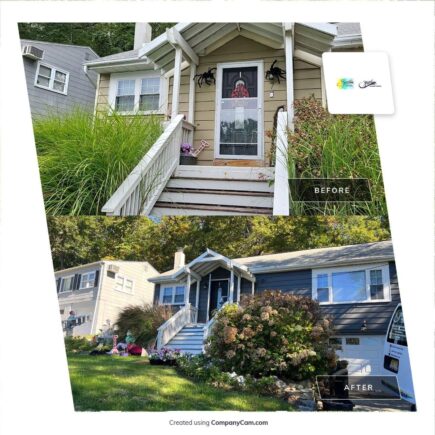
When it comes to enhancing the curb appeal and longevity of your home, a fresh coat of paint can work wonders. While the DIY approach might seem tempting, there are several compelling reasons why entrusting the task to a professional painting contractor like Spectrum Painting is the wisest choice. Let’s delve into the myriad benefits of hiring a professional for painting your home’s exterior.
- Expertise and Experience: Professional painting contractors bring years of experience and expertise to the table. They possess the necessary skills, knowledge, and techniques to deliver high-quality results efficiently. From surface preparation to paint application, they understand the nuances of each step, ensuring a flawless finish. Spectrum Painting has been servicing northern New Jersey since 1989!
- Quality Materials and Tools: A professional painting contractor has access to premium-quality paints, primers, and tools that may not be readily available to the average homeowner. They know which products are best suited for different surfaces and environmental conditions, ensuring durability and long-lasting results.
- Time and Efficiency: Painting the exterior of a home is a time-consuming task that requires meticulous attention to detail. By hiring professionals, you can save valuable time and effort. They work with precision and efficiency, completing the job in a fraction of the time it would take for a DIY enthusiast.
- Safety First: Painting the exterior of a home often involves working at heights and dealing with potentially hazardous materials. Professional painting contractors are well-versed in safety protocols and equipped with the necessary safety gear to protect themselves and your property. You can have peace of mind knowing that the job is being handled safely and responsibly.
- Customization and Guidance: Professional painters can offer valuable advice and guidance throughout the painting process. Whether you need help selecting the right colors or deciding on the appropriate finish, they can provide expert recommendations tailored to your preferences and the architectural style of your home. We’re also happy to provide a courtesy color consultation with our color expert before starting your project.
- Long-Term Savings: While the initial cost of hiring a professional painting contractor may seem higher than DIY, it can save you money in the long run. Their expertise ensures that the paint job is done right the first time, minimizing the need for costly touch-ups and repairs down the road. Additionally, quality paint application can help protect your home from the elements, potentially extending the lifespan of your exterior surfaces.
- Enhanced Curb Appeal: A fresh coat of paint can significantly enhance the curb appeal of your home, increasing its value and attractiveness to potential buyers if you ever decide to sell. Professional painters have an eye for detail and can achieve a flawless finish that will make your home stand out in the neighborhood.
In conclusion, hiring a professional painting contractor like Spectrum Painting to paint the exterior of your home is a worthwhile investment that offers numerous benefits. From expertise and efficiency to safety and long-term savings, our services can transform your home and leave you with stunning results that you’ll enjoy for years to come. So, why take on the daunting task yourself when you can sit back, relax, and let Spectrum Painting work their magic?

